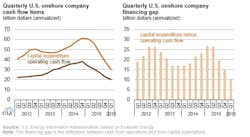As US oil companies’ spending falls and crude oil prices increase, their immediate financial situations are improving and the need for companies to find external sources of funding may decline.
According to an analysis from the US Energy Information Administration, first-quarter 2016 financial results from US onshore producers reveal an improving balance between capital expenditure and operating cash flow. Although operating cash flow was the lowest in any quarter in the past 5 years, larger reductions to capital expenditure brought these companies closest to self-finance, when capital investment can be paid for entirely from operating cash flow.
“Operating cash flow has declined over the past year, but it nonetheless has covered an increasing share of capital expenditure as companies are reducing their investment budgets more quickly," EIA said. "Smaller investment budgets are lowering the amount of cash US onshore oil producers need to raise through outside sources.”
With crude oil prices such as the global benchmark Brent price in the second quarter averaging more than $45/bbl—a 34% increase from first-quarter 2016—cash flow may improve and help offset declining revenue from lower production.
The companies included in this analysis are 39 public US crude oil producers operating only onshore fields. Their collective production averaged 2.1 million b/d, or 30% of US Lower 48 production in first-quarter 2016. These companies will release second-quarter 2016 results in mid-August.


